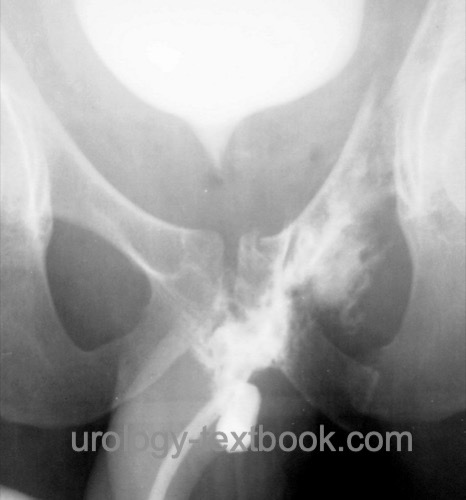You are here: Urology Textbook > Urethra > Posterior Urethral Injury
Posterior Urethral Injury
Definition
Posterior urethral injuries are most commonly an avulsion of the membranous urethra from the prostate as part of a pelvic ring fracture (Brandes et al., 2001) (Machtens et al., 2000). EAU guideline: Urological Trauma.
Etiology
Due to the fixed connection between the membranous urethra and the pelvic bone, pelvic fractures and the resulting force can lead to avulsion between the mobile prostate and the fixed urethra. The injury results in a pelvic hematoma and urinoma, which displaces the prostate further cranially.
Signs and Symptoms of Posterior Urethral Injury
Patients present with pelvic fracture, no urine output, bloody secretion from meatus, cranial displacement of the prostate on rectal examination, and urinary phlegmon in the absence of timely diagnosis.
Diagnosis of Posterior Urethral Injury
Retrograde urethrogram [fig. Urethrogram of posterior urethral injury], pelvic and abdominal CT.
 |
Treatment of Posterior Urethral Injury
Gentle trial of a transurethral catheter:
An option for patients with incomplete urethral tear in imaging. It is best done with the help of a hydrophile guide wire and X-ray control of the correct catheter position.
Suprapubic catheter:
A suprapubic catheter for posterior urethral injury is indicated for unstable patients (not able to undergo anesthesia, other urgent surgical procedures necessary) and if the trial of a transurethral catheter has failed.
Primary realignment with a transurethral catheter:
Suitable for stable patients (able to undergo anesthesia, no other urgent surgical indications). Under X-ray and visual control (retrograde and antegrade cystoscopy), a guidewire, and afterward, with the Seldinger technique, a 20 CH irrigation catheter is placed into the bladder. The catheter is removed after 2–3 weeks, there is a chance of primary recovery without further surgery. Impotence rates of 20–40% are more favorable than in patients with immediate or delayed surgical management. Short-distance strictures can be treated with endoscopic urethrotomy.
Immediate surgical treatment:
If the pelvic fracture has to be treated by open surgery, the suprapubic approach can be used for an end-to-end anastomosis of the membranous urethra. The advantage is the chance of a fast, definitive healing. Disadvantages are the high risk of bleeding, nerve injury with impotence (56%), and incontinence (21%) due to complex dissection in a bloody surgical field. Alternatively (with poor overview), the approach is used to place a transurethral catheter securely.
Delayed surgical treatment:
Definitive surgical treatment is sought after three months of healing. Patients with minor bladder dislocation may present with a short urethral stricture, which is treated with endoscopic urethrotomy. If a long urethral stricture develops, perineal access to the membranous urethra, excision of the stricture, and end-to-end anastomosis are performed.
Complications of Posterior Urethral Injury:
Stress incontinence (10–20%), erectile dysfunction (20–60%), recurrent urethral stricture (30–60%).
| Penile fracture | Index | Straddle injury |
Index: 1–9 A B C D E F G H I J K L M N O P Q R S T U V W X Y Z
References
EAU Guidelines: Urological Trauma
Brandes und Borrelli 2001 BRANDES, S. ;
BORRELLI, Jr.:
Pelvic fracture and associated urologic injuries.
In: World J Surg
25 (2001), Nr. 12, S. 1578–87
Koraitim 1999 KORAITIM, M. M.:
Pelvic fracture urethral injuries: the unresolved controversy.
In: J Urol
161 (1999), Nr. 5, S. 1433–41
Machtens u.a. 2000 MACHTENS, S.. ; STIEF,
C. G. ; HAGEMANN, J. ; PFINGST, G. ; GäNSSLEN,
A. ; POHLEMANN, T. ; TRUSS, M. C. ; KUCZYK,
M. A. ; BECKER, A. J. ; JONAS, U.:
Management traumatischer Läsionen von Harnblase und Urethra.
In: Urologe B
40 (2000), S. 560–571
 Deutsche Version: Verletzung der hinteren Harnröhre
Deutsche Version: Verletzung der hinteren Harnröhre
Urology-Textbook.com – Choose the Ad-Free, Professional Resource
This website is designed for physicians and medical professionals. It presents diseases of the genital organs through detailed text and images. Some content may not be suitable for children or sensitive readers. Many illustrations are available exclusively to Steady members. Are you a physician and interested in supporting this project? Join Steady to unlock full access to all images and enjoy an ad-free experience. Try it free for 7 days—no obligation.
New release: The first edition of the Urology Textbook as an e-book—ideal for offline reading and quick reference. With over 1300 pages and hundreds of illustrations, it’s the perfect companion for residents and medical students. After your 7-day trial has ended, you will receive a download link for your exclusive e-book.